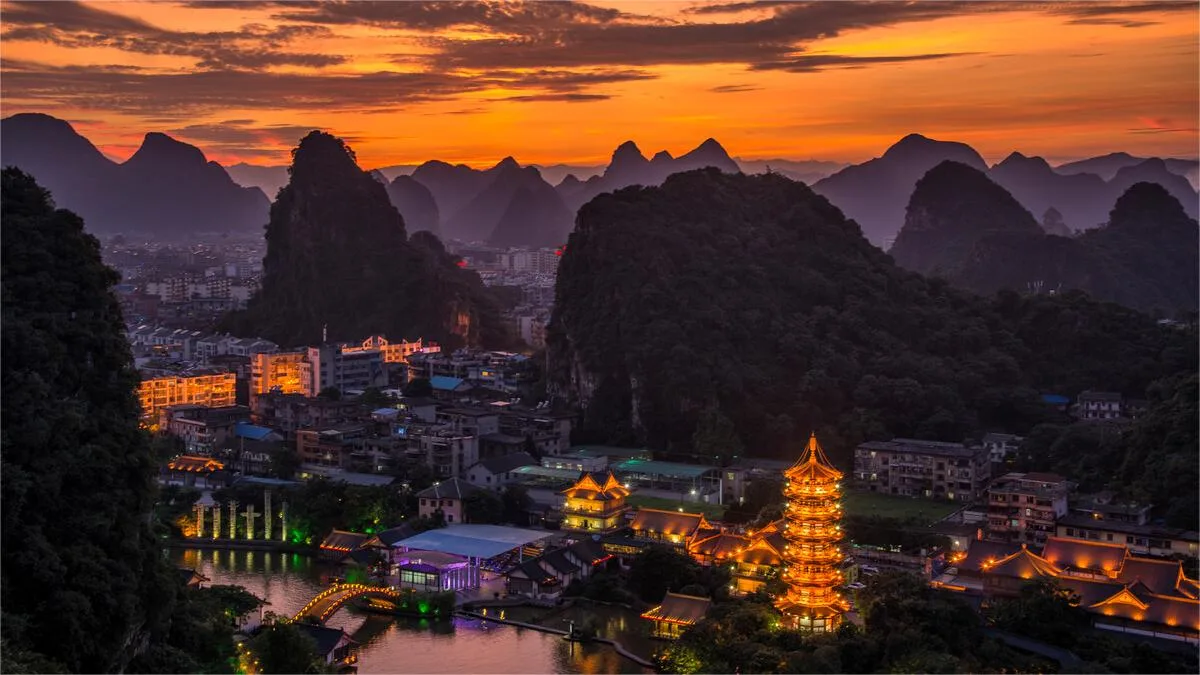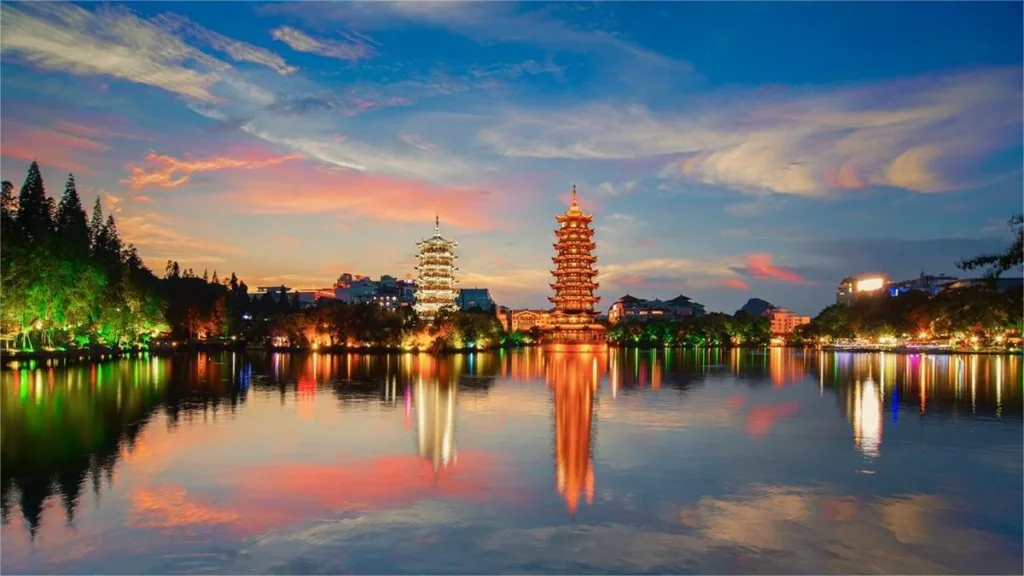Diecai Mountain (叠彩山), formerly known as Gui Mountain (桂山), is located in the northeast of Guilin City, covering an area of about 2 square kilometers. It includes the Four-Watch Mountain, Yu Yue Mountain, and two peaks: Mingyue and Xianhe. This tourist destination was developed by Yuan Hui, a Tang Dynasty observer and literary figure. According to historical records, it was named Diecai Mountain because of its stone patterns, which resemble layers of colorful silk brocade.
The main peak, Mingyue Peak, has an elevation of 223 meters. The Diecai Qionglou, situated in the valley between Mingyue Peak and Yu Yue Mountain, is now used as a Butterfly Pavilion, where thousands of butterflies create a spectacular sight.
From the Diecai Pavilion, you can gaze upon Mingyue Peak and see the layered mountain rocks that look like colorful silk ribbons. Climbing Mingyue Peak, the highest peak in the city, offers a panoramic view of the entire city. The top of Xianhe Cave in Diecai Mountain is the best spot for capturing the sunrise over Guilin, providing stunning, photo-worthy scenes.
Table of Contents
- Basic Information
- Location and Transportation
- Highlights of Diecai Mountain
- Vlog about Diecai Mountain
- Climate and Best Travel Time
- Other Attractions in Guilin Urban Area
Basic Information
| Estimated Length of Tour | 1 – 2 hours |
| Ticket Price | 25 RMB |
| Opening Hours | 6.30 – 18.30 (1st April – 31st October) 7.00 – 18.00 (1st November – 31st March) |
| Telephone Number | 0086-0773-2100680 0086-0773-2100676 |
Location and Transportation
Diecai Mountain is located in the northeastern part of Guilin city, Guangxi Zhuang Autonomous Region, at 2 Longzhu Road, beside the Li River. To get there, you can take bus 2, 203, or Sightseeing Bus 1 and get off at Diecai Mountain Stop (叠彩山站).
Highlights of Diecai Mountain
Diecai Qionglou

Diecai Qionglou is located between Mingyue Peak and Yu Yue Mountain on Diecai Mountain. This large scenic garden architecture complex is based on the northern Guangxi Dong ethnic group’s architectural style and covers an area of 1,300 square meters. Completed in 1990, Diecai Qionglou’s central axis consists of a drum tower and connecting corridors, dividing the structure into eastern and western courtyards. The eastern courtyard features winding paths that lead to secluded areas, while the western courtyard is open and spacious, connected by small bridges. The courtyards are centered around a pond, with a high pavilion to the east, a pavilion and corridor to the west, a multi-story building to the south, and a waterside pavilion to the north. The main drum tower is a two-story pavilion with a gable and hip roof, and its front features a small open veranda with a curved roof. The rest of the structures are one or two stories with sloped roofs, including sections with double or triple eaves, and some with six or eight-sided pointed roofs. The entire complex is well-proportioned, richly layered, and harmoniously integrated with the natural environment, creating a fairy-tale-like atmosphere.
Wangjiang Pavilion
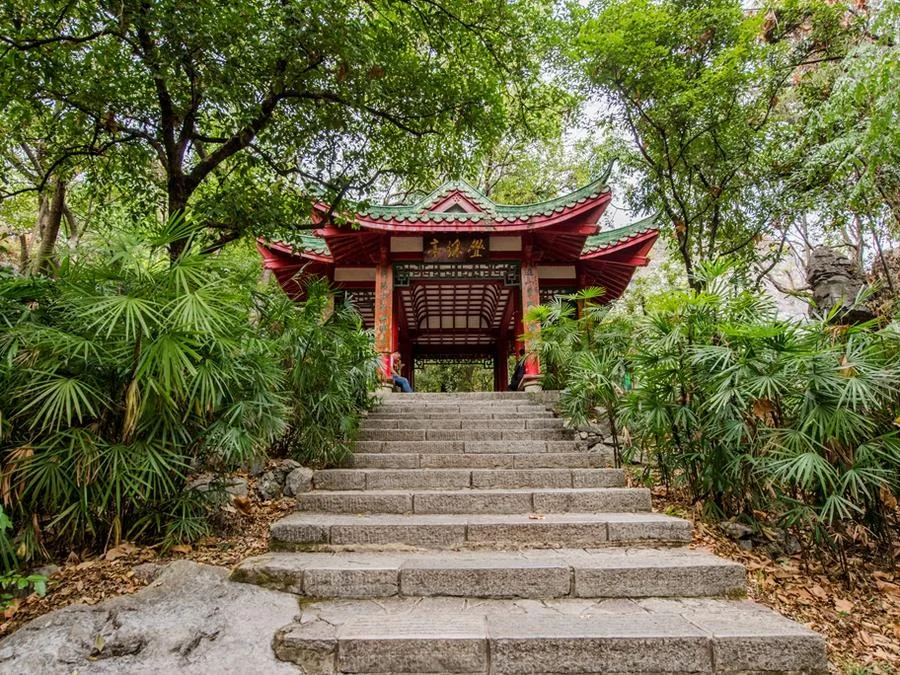
Wangjiang Pavilion is located halfway up the northern slope of Diecai Mountain. Originally built during the Zhengde period (1506-1521) of the Ming Dynasty by the eunuch Fu Lun, who served as an imperial envoy and governor of Guangxi, the pavilion reflects his deep appreciation for the landscapes of Guilin, particularly Diecai Mountain, which he visited seven times. His poem “Wangjiang Pavilion” describes the pavilion’s scenic features with lines such as “The mountain colors are as green as Buddha’s clouds, the stream reflects an empty blue sky, the pavilion leans on the Wind Cave, feeling transcendent and at ease.” The original pavilion was long abandoned but was rebuilt twice, in 1954 and 1990, on the original site. The pavilion now stands approximately 6 meters high with red columns, green tiles, upturned eaves, and a pointed roof. It measures 5.2 meters long from north to south and 4.9 meters wide from east to west, with a total area of about 25.5 square meters. The right wall of the pavilion bears the engraved words “探奇处 Exploring the Wonders,” and the pavilion offers a vantage point for discovering the surrounding scenic beauty.
Mingyue Peak
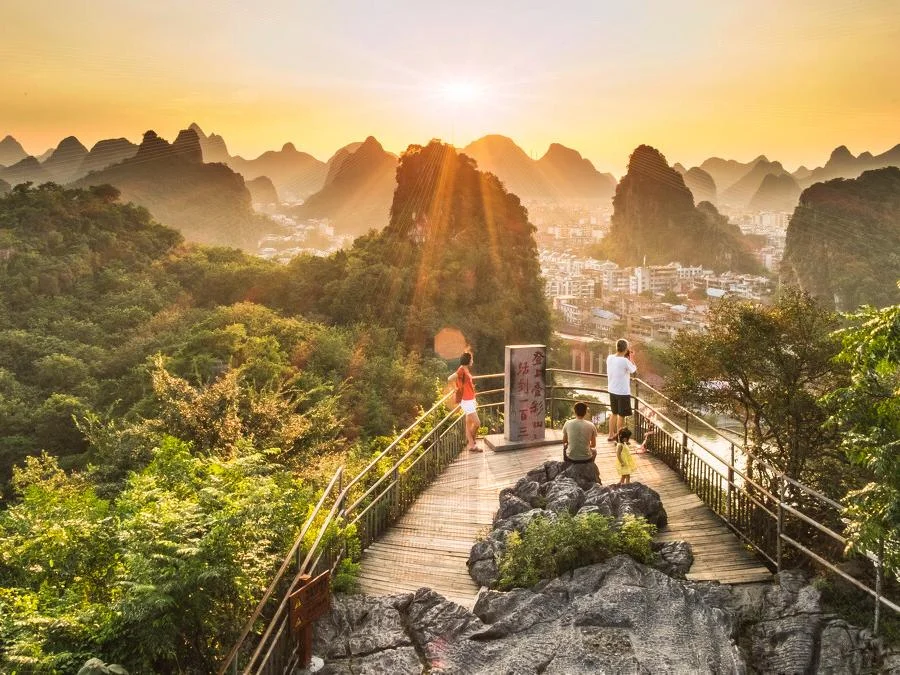
Mingyue Peak, the main peak of Diecai Mountain, is located in the northeast of the mountain. It stands at an elevation of 223 meters with a relative height of approximately 73 meters and covers a total area of 1.41 hectares. Both the Qing Dynasty poet Yuan Mei and the Ming Dynasty Deputy Minister of War Yang Fang remarked on the peak’s height, which is said to be high enough to catch the moon, hence the name Mingyue Peak. The summit features a small platform shaped like a gourd, known as Ma Wang Tai, built by Ma Yin during the Five Dynasties period. During the Song Dynasty, Zhang Zhu, the governor of Jingjiang, constructed two altars named “Yao Mountain” and “Li River” on the peak to offer sacrifices to the mountains and rivers. Mingyue Peak is renowned for its height, steepness, and picturesque beauty. It stands majestically by the river, with its peak resembling a bamboo shoot and its layered rock formations gradually rising higher. From the top, one can enjoy panoramic views of the city in spring, the fields, and the unique peaks in the distance.
Mulong Ancient Pagoda
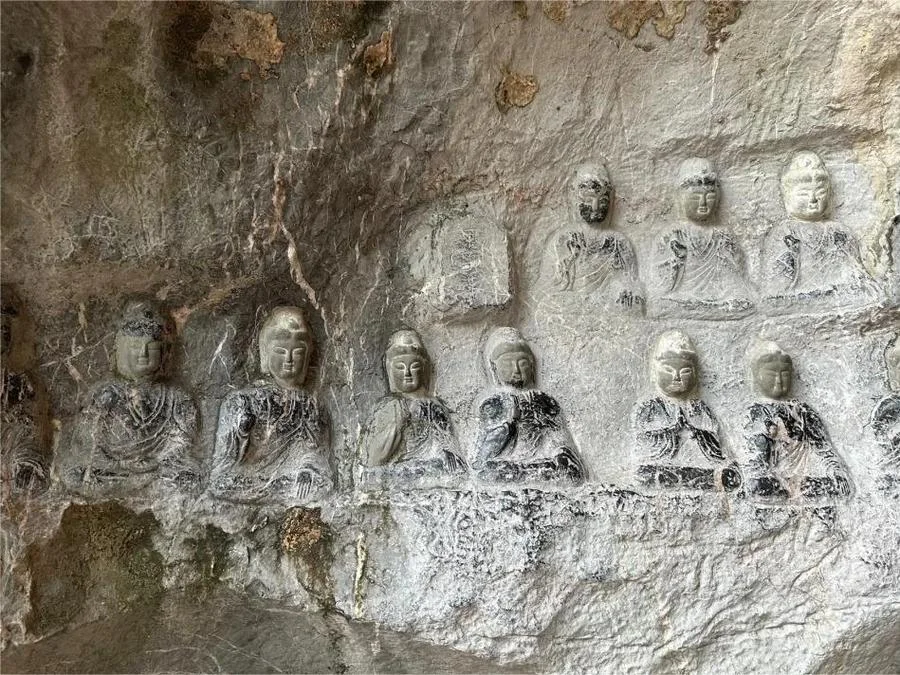
Mulong Ancient Pagoda is a key cultural relic protection unit in the Guangxi Zhuang Autonomous Region. It is located on the eastern slope of Diecai Mountain within the city. Built during the Tang Dynasty, the pagoda is of a round lamaist style and stands 4.34 meters tall. The base is composed of three layers of drum stones, with the drum walls engraved with patterns of inverted lotus flowers. The pagoda body is in the shape of a precious bottle, with niches on all four sides. The east and west niches contain carvings of Buddha statues, while the north and south niches feature Bodhisattvas, all seated in the lotus position on lotus petal thrones. The neck of the pagoda has twelve levels of phase wheels, topped with a six-sided umbrella-shaped cover and crowned with a gourd-shaped pinnacle. The six corners of the umbrella cover originally had holes from which bronze bells and iron horses were hung, although these no longer exist. This uniquely styled pagoda holds significant value for the study of ancient Chinese pagoda architecture.
Wind Cave
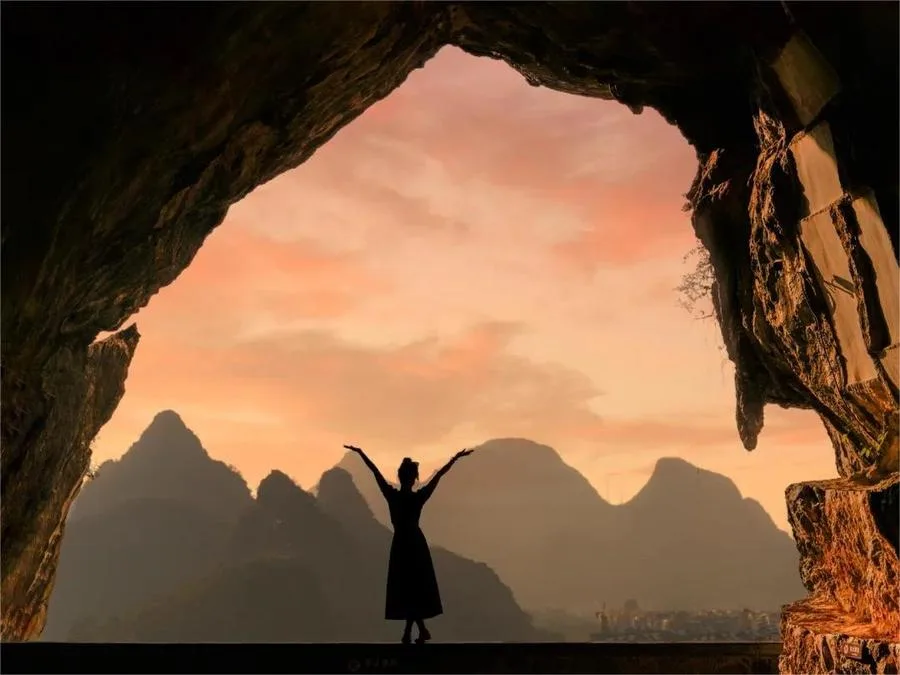
Located halfway up Mingyue Peak, Wind Cave is a unique cavern that runs north to south, with a narrow middle section that allows only one person to pass through at a time, creating two open ends. Shaped like a gourd, the cave spans 20 meters in length, with a maximum width of 9.2 meters and a height of 5 meters, covering a total area of about 140 square meters. Originally an ancient underground river channel, Wind Cave features a high-altitude location connecting the “Xiang-Gui Corridor” to the north and the “Gorge Passage” between Jiayao Bridge Ridge and Ocean Mountain to the south. This setup creates a convection effect, where large cross-sections at both ends and a narrow middle section increase wind speed and decrease pressure, constantly replenishing the airflow. With seasonal variations, the wind can be cool, warm, or cold, earning Wind Cave the reputation of a “cool world” due to its continuous and refreshing breeze.
Vlog about Diecai Mountain
Climate and Best Travel Time
Diecai Mountain is located in the Guilin region of Guangxi, which experiences a subtropical monsoon climate. The climate is mild with long summers and short winters, abundant rainfall, and ample sunshine. The average annual temperature is 19 degrees Celsius, and the area enjoys distinct seasons with no severe cold in winter or extreme heat in summer. When planning a trip, it is essential to monitor weather changes to avoid any disruptions. The best times to visit are June and October when the weather in Guilin is relatively cool, with average temperatures around 25 degrees Celsius, making it ideal for hiking.

